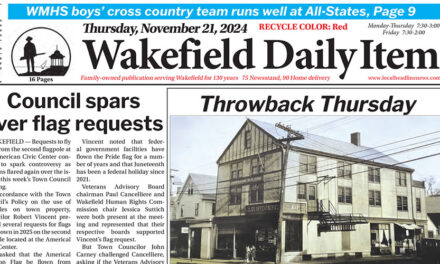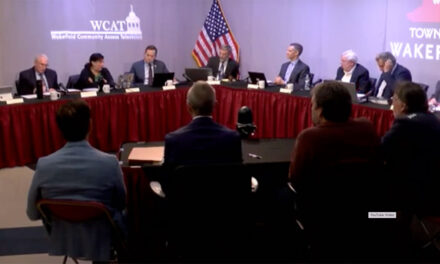By MARK SARDELLA
WAKEFIELD — Of the $8 million in American Rescue Act (ARPA) funds that Wakefield received, the town has about $6.5 million left that must be spent or obligated by Dec. 31, 2024.
At this week’s Town Council meeting, Town Administrator Stephen P. Maio reviewed the expenditures to date as well as ideas received from Town Councilors, town department heads and the public regarding how the remaining money should be spent.
The federal American Rescue Plan Act, signed into law March 11, 2021, commonly known as ARPA, is providing funds to the Commonwealth and its municipalities from the Coronavirus State Fiscal Recovery Fund and Coronavirus Local Fiscal Recovery Fund.
Wakefield’s share of the funds totaled $8,083,935.
Maio pointed out that the following expense categories were determined to be eligible uses for the ARPA funds: public health spending; economic impacts of the public health emergency; lost public sector revenue; premium pay for essential workers; water, sewer, and broadband infrastructure.
However, Maio noted that it was subsequently decided that a municipality may spend up to $10 million of ARPA funds on any legitimate government services, with a number of exceptions. The funds cannot be used for funding debt service or replenishing
reserves, settling judgments, tax reduction, pension fund deposits or undermining of CDC mitigation practices.
Since Wakefield’s total was under $10 million, Maio noted, the town has wide latitude regarding how it may spend the funds. He listed the areas where the town spent the first $1.5 million.
In the FY 2022 Budget, $20,352 went to Town Hall expenses and $18,750 to the Police Department. The schools got $400,000.
In the FY 2023 budget, Town Hall got $21,500. Another $145,000 went to the Health Department budget. The schools got $363,000.
An additional $75,000 is proposed to go to the Health Department in FY 2024.
Another $534,141 was spent on school and first responder overtime, contact tracing, COVID test kits, clinics, elections and town meeting; potential Fire Department overtime and the Fit Court at Moulton Field.
At a webinar held by the town last December to discuss potential uses of the remaining $6.5 million, a number of ideas were proposed, including: increased mental health services for students and residents; outdoor projects including green space; pedestrian access and amenities; pop-up events; essential worker pay; and business support including outdoor dining and façade improvements.
The town also put out a public survey asking residents how they would like to see the funds used, Maio said.
A total of 57 residents responded to the survey. Forty-five percent suggested premium pay for essential workers; 18 percent wanted spending on outdoor amenities (sidewalks and green space); 12 percent wanted funds spent on provision of masks and testing; another 12 percent cited other infrastructure needs; 8 percent wanted tax relief (not an eligible use of ARPA funds); and 7 percent suggested spending on mental health and wellness.
The Town Council was also asked to suggest uses for the remaining ARPA funds.
Their suggestions for spending on infrastructure included: Lake path feasibility and construction ($1,000,000; Envision Wakefield/Upper Common area improvements ($3,500,000); Lake Quannapowitt cleanup ($500,000); sidewalk expansion town-wide ($250,000); a splash pad ($200,000): ADA accessible playground equipment ($150,000); video conferencing technology for all town meeting rooms ($100,000); renovations to the ACE Center ($500,000); and public shade trees ($150,000).
Additional suggestions from the Town Council included: another turf field and track ($2,000,000); a housing expansion for seniors study ($100,000); senior housing development ($1,000,000); senior housing project – Hurd School building ($500,000); solar field ($500,000); Greenwood beautification ($2,000,000); sign/fence replacements ($250,000); a water truck for town events ($55,000); veterans’ monuments restoration ($250,000); and town-wide energy improvements ($250,000).
The Town Council infrastructure suggestions totaled $13,255,000. They also came up with a number of other suggestions totaling an additional $4,234,000. Those included a façade program for downtown businesses ($250,000), an innovation space for businesses ($250,000), WCAT support ($634,000), downtown property redevelopment ($3 million) and hiring a Town Planner ($100,000).
Another $250,000 was suggested for a heating contingency fund to help residents.
Maio said that town department heads were also asked for their suggestions. Their ideas included: replacing the Senior Center gym equipment ($8000); Conservation Title Searches ($25,000); turf field replacement ($850,000); Rail to Trail/Envision ($1,000,000); brush fire apparatus ($250,000); new lighting at Veteran’s Field ($250,000); ADA accessible swings ($100,000); and funding the town’s FY2024 Capital Plan ($2,000,000).
Additional suggestions from department heads included water main improvements ($2,500,000); drones for the police department ($25,000); a new fuel island for the DPW yard ($150,000); Moulton Playground upgrades ($300,000); and funding a MWGLD low income/energy efficiency program at $2,000,000.
The total amount for the requests from town department heads was $9,208,000. The grand total for the suggestions from the public, the Town Council and department heads was $26,947,000.
Town Council chair Mehreen Butt suggested that the board and the public take a look at the listed suggestions and think about what would help the most people.
Town Councilor Jonathan Chines recommended that each Town Councilor create a list of priorities that would fit within the $6.5 million available.
The board is expected to vote at future meetings on uses for the remaining ARPA funds.




